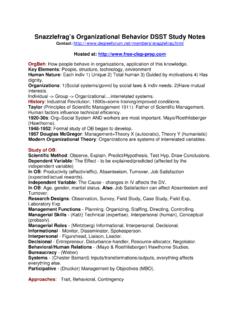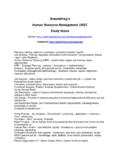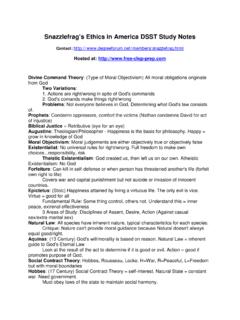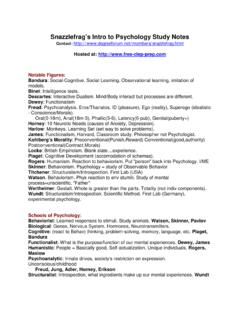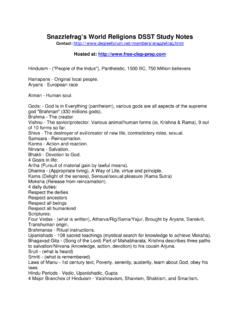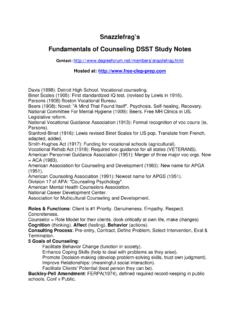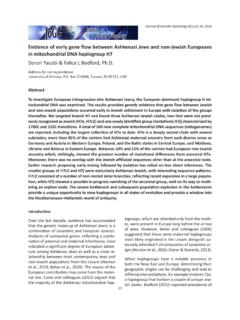Transcription of Snazzlefrag’s Lifespan Development Psychology DSST …
1 snazzlefrag sLifespan DevelopmentPsychologyDSST Study NotesContact: at: Dev Psych: science that seeks to understand how and why peoplechange/stay the : Physical growth & Development . Family, community, cultural factorsCognitive: Mental processes. Think, learn, communicate, perception, memory, :Conservation=Different shape but same mass,Permanence=Out of sightmeans : Changes schema to fit new : Incorporates new info into existing : New info doesn't fit into existing (0-2) No object permanence. Causality. Trial and error (2-6) No conservationor logic. Transduct. Object Perm, Symbolic lang,Egocentric, Operational (6-12) Conservation, think logically, logical concepts/rules to solveconcrete Operational (12+) Scientific, Hypothetical thinking about : 1st to show evidence of innate linguistic capacity in humans (ChallengedSkinner's Behaviorism).
2 Ecological:Bronfenbrenner. Spheres of Influence, nested inextricably. Complexphysical, :Maslow:Lower/External<---Physiological, Safety | Social,Esteem, Self-actualization--->Higher/InternalRogers: Schemas, Accomodation: Revise for new info. Adaptation: Adjust + keep upwith : emotions, personality, 's Psycho-social Develpment: Tension (disequilibrium)is necessary v. Mistrust (0-1) Depend on others: Are others reliable? v. Doubt/Shame (1-3) Capable fo Self-control: Allowed to exercise it? ToiletInitiative v. Guilt (3-5) Can set goals: Is that encouraged? IndependenceIndustry v. Inferiority (6-11) Can reason, likes success: Praised and taught? v. Role Confusion (12-18) Identity/multiple roles: Integrate all roles? v. Isolation (18-35) Break from family, new rels: Willing to share yourself?
3 V. Stagnation (36-55) Kids are gone (free): Show interest in others? v. Despair (55+) Reflecting on life: Accept it all? Reflect/Accept one's Perspective: Bowlby. Behaviors/emotions are adaptive to further need for contact: Unfamiliar, source of 's Psychosexual Stages:Oral(0-18m) Sucking & FeedingAnal(18m-3) ToilettrainingPhallic(3-6) Penis envy. Oedipal/Electra ComplexLatency(6-pub) Interlude, quiet stage, conventional activities (school-work/sports etc.)Genital(puberty+) Sexual stimulation and : Attachment is stable with : added to Erikson, used longitudinal studies. Career :Vygotsky. "Zone of Proximal Dev". Apprenticeship. Assisted Perf >Independent : 100kGenesin humans. Basic unit of heredity. Segments of :Down's Syndrome (Trisomy 21): Extra 21st chromosome.
4 Related to maternal : involuntary movements, speech problems, (PKU): If both parents. Easy to treat(limit protein). Severe mentalretardation w/o : Ashkenazi. Hexo. Death before age 4. Retardation, blind, red spots onmacula, lge : Hereditary anemia. Medit & SE Asia. Often Syndrome: Single X, no Y (XO). Females. Mentally impaired, but not : Molescule of DNA carries genes from parent to offspring. 23 Genes: Brown eyes. ONE brown eye gene = brown : Entire genetic inheritance. All genes that a person : Pictured arrangement of chromosomes for : Observable characteristics resulting from genes. (hair, eyes, height etc.)Polygenic Traits: Characteristics produced by interaction of many Genes: Blue eyes. Requires TWO blue eye genes = blue Development : Gametes (Sperm + Ovum) = Zygote (half from each).
5 Germinal / Pre-embryonic Stage: 0-14 : Day 15-Week : Week 9-Term (38-40 weeks). 24wks =Age of : 1st (0-12wks), 2nd (13-27wks), 3rd (28-40wks).Prenatal Life Support:Placenta: (progesterone from corpus luteum) 3 Functions: Transport, endocrine, (pregnancy test), HPL, Estrogen, Progesterone, Relaxin. Fatty acids, glycogen, Cord: 21inches. 2 arteries(to mom), 1 vein(to baby). Surrounded byWharton's waste and Carbon Dioxide. Delivers nutrients, hormones, Nutrition: Calcium, folic : External Agents: Diseases, viruses, drugs, chemicals, : Low-brith weight = < lbsBradley Method (husband coached): abdominal breathing, ambulation, focal point(alleviate pain).Psychosexual Method: Relaxation, progressive breathing, flow with contractions ratherthan Method: Fear = tension = pain.
6 Abdominal breathing with Method (psychoprophylactic): Stimulus/Response Conditioning. :1st Stage: Contractions to Full Dilation of Phase (preparatory): Onset to rapid cervical Phase: 4cm to 7cm. Stronger contractions: 40-60secs each, 3-5mins Phase: Max dilation8-10cm. Intense contractions. Ireesistable urge to Stage: Full dilation to birth. Crowning to pushing fetus out of the birth Stage (Placental Stage): Seperation (5 mins after birth), Expulsion (bear down orgentle ext pressure).Neonatal Assessment:APGAR Scoring: 1min then repeated every 5mins. Score: <4=poor, 4-6=fair,7-10=excellentHeart Rate: 0=absent, 1=slow(<100), 2= >100 Respiratory Effort: 0-absent, 1=slow/irregular/weak cry, 2=good strong Tone: 0=flaccid,1=some extremity flexion, 2=well Irritability: Nostrils or soles of feet.
7 0=no response, 1=grimacing,2=cough/sneeze/cry or withdraw : 0=blue or pale, 1=body pink/extremities blue, 2= completely Scale: Behavior/responses of newborn. Interaction, Motor Response, Activity, & Toddler:Reflexes:Newborn Reflexes: Simple motor skills, involuntary responses to a 's Reflex: Toes fan and flex when foot is Reflex: Extension Reflex: Stroking foot while held down = flex/extend of other : Until 4mnths. Pushes tongue out when tip is touched. Easier Reflex: Lying prone = will turn shoulder and pelvis to stimulated side when skinnear spine is Reflex: Startle. If startled, baby punches arms outward then brings them in to Grasp: Fingers flex and grasp a finger placed across Reflex: Backward step ontoa firm surface when one foot is already : Turn head to side when corner of mouth is Reflex: Feet move in stepping patterns when held up with feet touching : When lips are Reflex: If held horizontally on stomach, arms and legs stretch out inswimming Neck: Fencing reflex.
8 Flex/extend limbs when head is Development : Double birthweight by 4mnth, triple by 1yr. Slower growth in2nd : Growth from head to toe. Newborn Head = 1/4 of total body length,Adult = 1 : Growth from spine : Birth-2=fivefold increase in density of dendrites in cortex. "TransientExuberance".Motor Skills: Newborn=cry,shiver,tuck legs (hunger). 6months=roll : Newborn=see,hear,smell,taste,pressure,mo tion,temp,pain. Narrow range Development : Habituation (get used to repeated stimuli), Sensorimotor (toexplore environment)Object Permanence (8mths): Objects still exist even when not (Piaget): Reflex(<1m), Adaptation(1-4m),Respond to people(4-8m),Anticipation(8-12m),Experim entation(12-18m), Mental Combinations(18-24m).Perceptual Development : Constancy(size remains same even if relocated),Cross-modal, Development :Newborn: reflexive cries, movements, facial : Cooing, fussing, crying, : squeals, growls, croons, trills, vowel :Babbling, repeated consonant and vowel sounds in : First recognizable : Up to 50 : Vocabulary spurt.
9 3+ words per : First 2-word : Multiword sentences. 50% of utterances are 2+ words Development :Attachment: Healthy = secure when parent is present, distressed when leave,comforted when Five: Extroversion, Agreeableness, Conscientiousness, Neuroticism, : Fear, anger, sad, happy, surprise. Increase towards : Sens of right or wrong during prosocial behavior = : 15-24m. Lipstick on nose/mirror test. Self-aware=touch OWN Wariness: First noticed about 6m, full-blown by : Activity, Rhythmicity, Approach-withdrawal, adaptability, Intensity ofreaction,Threshold of responsivity, quality of mood, distractibility, attention span. [Extrovert,placid, shy]Early Childhood: The Play Years (age 2-6)Physical Development : Boys taller and heavier than girls. 3 inches per yearr.
10 , Development :Gross: Running, climbing, jumping, throwing. 2yr=clumsy, 5yr=more : Hard for preschoolers to master. Gradually improve over Development : 2yr=75% adult wt, 5yr=90% adult wt. Brain growth occurs inspurts and Hemisphere: (visual) growth spurt Callosum: growth at 5yr = form links between spoken and written : Decreased growth 2-6yrs so fewer calories, smaller Development :Piaget: Preoperational, symbolic thought,Centration=Daddy but not bro, uncle : Zone of Proximal Development . Need help from adults. Social Development :Fast mapping (heard once). Can = misuse (ie, 'Big' means tall, big, old, great).Grammar is apparent in toddler's 2-word sentences. Noun before verb. No need totalkdownto 3yr Development : Emerging self-concept. "I am a girl.
